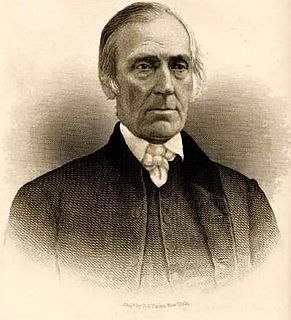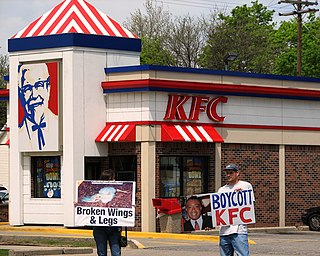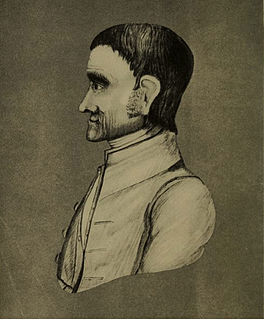
Thomas Clarkson was an English abolitionist, and a leading campaigner against the slave trade in the British Empire. He helped found The Society for Effecting the Abolition of the Slave Trade and helped achieve passage of the Slave Trade Act of 1807, which ended British trade in slaves.

Levi Coffin was an American Quaker, abolitionist, businessman, and humanitarian. He was an active leader in the Underground Railroad in Indiana and Ohio and was given the unofficial title of "President of the Underground Railroad." An estimated three thousand fugitive slaves are believed to have reported having passed through his care. The Coffin home is in Fountain City, Indiana, and is often called the "Grand Central Station" of the Underground Railroad.

Elias Hicks was a traveling Quaker minister from Long Island, New York. In his ministry he promoted unorthodox doctrines that led to controversy, which caused the first major schism within the Religious Society of Friends. Elias Hicks was the older cousin of the painter Edward Hicks.

Christian views on slavery are varied regionally, historically and spiritually. Slavery in various forms has been a part of the social environment for much of Christianity's history, spanning well over eighteen centuries. In the early years of Christianity, slavery was an established feature of the economy and society in the Roman Empire, and this persisted in different forms and with regional differences well into the Middle Ages. Saint Augustine described slavery as being against God's intention and resulting from sin. In the eighteenth century the abolition movement took shape among Christian people across the globe.

Benjamin Lay was an Anglo-American Quaker humanitarian and abolitionist. He is best known for his early and strident anti-slavery activities which would culminate in dramatic protests. He was also an author, farmer, and early vegetarian.
The Religious Society of Friends (Quakers) played a major role in the abolition movement against slavery in both the United Kingdom and in the United States of America. Quakers were among the first white people to denounce slavery in the American colonies and Europe, and the Society of Friends became the first organization to take a collective stand against both slavery and the slave trade, later spearheading the international and ecumenical campaigns against slavery.
The New York Manumission Society was an American organization founded in 1785 by U.S. Founding Father John Jay, among others, to promote the gradual abolition of slavery and manumission of slaves of African descent within the state of New York. The organization was made up entirely of white men, most of whom were wealthy and held influential positions in society. Throughout its history, which ended in 1849, the society battled against the slave trade, and for the eventual emancipation of all the slaves in the state. It founded the African Free School for the poor and orphaned children of slaves and free people of color.

James Mott was a Quaker leader, teacher, and merchant as well as an anti-slavery activist.

The history of slavery in Kentucky dates from the earliest permanent European settlements in the state, until the end of the Civil War. Kentucky was classified as the Upper South or a Border state, and enslaved African Americans represented up to 25% of the population before the Civil War, concentrated in the cities of Louisville and Lexington, both in the fertile Bluegrass Region, a center of tobacco plantations and horse farms.
Elizabeth Heyrick was an English philanthropist and campaigner against the slave trade.

Mary Anne Rawson (1801–1887) was an abolitionist. She was a campaigner with the Tract Society, the British and Foreign Bible Society, Italian nationalism, Child labour, but above all anti-slavery. She was first involved with a Sheffield group who successfully campaigned for people to boycott sugar from the West Indies, as it was produced by slave labor. She is pictured attending the World Anti-Slavery Convention in London in 1840.

Lucretia Mott was a U.S. Quaker, abolitionist, women's rights activist, and social reformer. She had formed the idea of reforming the position of women in society when she was amongst the women excluded from the World Anti-Slavery Convention in 1840. In 1848 she was invited by Jane Hunt to a meeting that led to the first meeting about women's rights. Mott helped write the Declaration of Sentiments during the 1848 Seneca Falls Convention.

Abolitionism in the United States was the movement before and during the American Civil War to end slavery in the United States. In the Americas and western Europe, abolitionism was a movement to end the Atlantic slave trade and set slaves free. In the 17th century, enlightenment thinkers condemned slavery on humanistic grounds and English Quakers and some Evangelical denominations condemned slavery as un-Christian. At that time, most slaves were Africans, but thousands of Native Americans were also enslaved. In the 18th century, as many as six million Africans were transported to the Americas as slaves, at least a third of them on British ships to North America. The colony of Georgia originally abolished slavery within its territory, and thereafter, abolition was part of the message of the First Great Awakening of the 1730s and 1740s in the Thirteen Colonies.
Although many Enlightenment philosophers opposed slavery, it was Christian activists, attracted by strong religious elements, who initiated and organized an abolitionist movement. Throughout Europe and the United States, Christians, usually from 'un-institutional' Christian faith movements, not directly connected with traditional state churches, or "non-conformist" believers within established churches, were to be found at the forefront of the abolitionist movements.
Anna Richardson was an English Quaker slavery abolitionist and peace campaigner, and a writer and editor of anti-slavery texts and journals, based in Newcastle Upon Tyne.
Warner Mifflin was an American abolitionist. Born and raised in Virginia, Mifflin established himself as a planter in Delaware in 1769. As a member of the Society of Friends, he was strongly opposed to slavery and became dedicated to assisting slaves who tried to free themselves, to defending free blacks from abuse, as well as encouraging Quakers and others to free their slaves.
William Fox was a radical abolitionist pamphleteer in late 18th-century Britain. Between 1773 and 1794 he ran a bookshop at 128 Holborn Hill in London; from 1782 he was in a business arrangement with the Particular Baptist Martha Gurney, who printed and sold his and others' pamphlets. His most famous work, published in 1791, was An Address to the People of Great Britain, on the Propriety of Refraining from the Use of West India Sugar and Rum. In emotive and graphic language, it urged Britons to boycott the produce of enslaved Africans in the British West Indies, claiming, "[a] family that uses only 5lb. of sugar per week, with the proportion of rum, will, by abstaining from the consumption 21 months, prevent the slavery or murder of one fellow creature; eight such families in 19 1/2 years, prevent the slavery or murder of 100, and 38,000 would totally prevent the Slave-Trade to supply our islands ... in every pound of sugar used, the produce of slaves imported from Africa, we may be considered as consuming two ounces of human flesh." The Address became the most widely circulated 18th-century pamphlet, going through 26 editions in less than a year, with over 200,000 copies distributed in Great Britain and the United States.



















